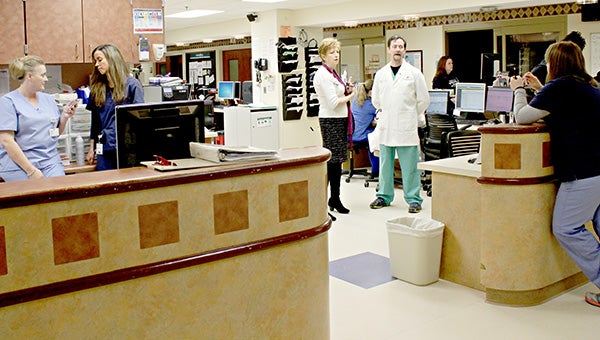Teamwork saves lives in the emergency room
Published 10:43 am Monday, January 11, 2016

- SYNERGY: A team of 50 employees work together each day to treat about 100 patients per day at River Region Medical Center Emergency Room.
Heroes come in all shapes and sizes and wear all kinds of uniforms. Most can’t do their job without the help of others and some work in teams to get the job done.
The team of people working in the emergency room of Merit Health River Region Medical Center need each other to help save lives daily.
River Region has a 14 bed emergency department and a four bed fast track, where clinic patients are taken from 11 a.m. to 11 p.m. The ER staff holds multiple certifications including cycle IV chest pain accreditation, level IV trauma accreditation and the team is working towards their stroke accreditation.
“All of our nurses are ACLS certified, which is Advanced Cardiac Life Support, PAL certified, which is Pediatric Advanced Life support,” Claudia Fridge, clinical manager, said.
Another certification the staff must receive is TNCC, Trauma Nurse Core Curriculum, within their first year of working in the ER. Several nurses are also SANE certified, or Sexual Assault Nurse Examiner, through a 40-hour class.
“There are a lot more certifications with emergency medicine,” Leigh White, director of marketing corporate programs, said. Fridge said this is because the staff tends to see all ages and all ailments.
“We see everybody,” Fridge said. “We see babies all the way to geriatrics. We take care of trauma patients, critical care patients, codes…We take care of everything.”
For Fridge and Carmen Morgan, director of the ER, becoming a nurse came from a draw they felt in their life to help people.
“Just taking care of people, making people feel better and trying to serve the public,” are reasons Morgan said she became a nurse.
Morgan started working as a nurse at 19 and has been working for 25 years with a background in long-term acute care, travel nursing and ER. While Morgan’s job is more administrative, Fridge’s job pertains mostly to the clinical side of operations.
Fridge has been in the ER for 20 years where she started as a staff nurse on night shift, then she became a charge nurse on day shift, next she moved to the clinical coordinator position and on three different occasions she stepped in as the interim emergency department director.
She enjoys being the clinical manager where her responsibilities include helping the staff, scheduling, calling back discharged patients, chart reviews, payroll and teaching rapid response code blue for heart attacks every two weeks to new nurses.
“ER nurses respond to every code blue and every rapid response, that’s when a patient’s signs and systems, if they’re on the floor, are deteriorating,” Fridge said.
Fridge said an important component of working in the ER is learning how to prioritize your time between multiple patients in need.
“You have to basically have nursing skills to know which patient is the sickest and which one you need to see first,” Fridge said.
She and Morgan said nurses do all kinds of jobs outside of medical procedures when it comes to taking care of their patients like arranging places to stay, transportation and a little bit of social work.
“Nurses wear many hats,” Morgan said.
Fridge loves to be out on the floor assisting the nurses in their daily operation, and her favorite part of the job is when patients take the time to say thank you. Robin Greer, trauma registrar and stroke lab coordinator, agreed with Fridge that it’s encouraging when the nurses see good outcomes because they do deal with many heartbreaking cases.
“We support each other and work well together, and you have to have that,” Fridge said. “We have a strong team.”
The team of doctors and nurses is able to do what they do because of each other. Fridge said over 50 people are employed in the ER, and they see around 100 patients a day.
“It takes everybody to run the department,” Greer said. “We have a good family here. We’re all good friends.”





